21. Multiple Integrals in Curvilinear Coordinates
a. Integrating in Polar Coordinates
4. Applications
Integrals in polar coordinates are particularly useful when the integrand and/or the region of integration are easily expressed in terms of polar coordinates. We previously did Applications of Double Integrals in rectangular coordinates. All of those applications can also be done using polar coordinates.
All the examples on this page of applications of double integrals in polar coordinates will use the crescent shape inside the circle \(r=4\cos\theta\) but outside the limacon \(r=1+2\cos\theta\) as shown in the pink region of the plot. Find the bounds on the integrals.
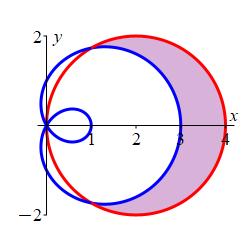
The \(\theta\)-bounds on the integrals are the angles of intersection. So we equate the values of \(r\): \[\begin{aligned} 4\cos\theta&=1+2\cos\theta \qquad 2\cos\theta=1 \\ \cos\theta&=\dfrac{1}{2} \qquad \theta=\pm \dfrac{\pi}{3} \end{aligned}\] The lower bound (smaller value) of \(r\) is the limacon \(r=1+2\cos\theta\) and the upper bound (larger value) is the circle \(r=4\cos\theta\).
Volume
Recall that the volume under a surface \(z=f(x,y)\) above a region \(R\) in the \(xy\)-plane is: \[ \text{Volume}=\iint_R f(x,y)\,dA \] When using polar coordinates, as in the examples below, the function and differential must be expressed in polar coordinates \(r\) and \(\theta\): \[ \text{Volume}=\iint_R f(r,\theta)\,dA =\iint_R f(r,\theta)\,r\,dr\,d\theta \]
Find the volume of the solid above the crescent shape, below the surface \(z=\dfrac{1}{\sqrt{x^2+y^2}}\).
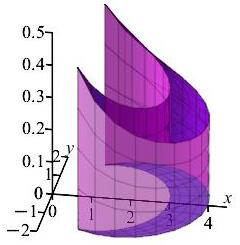
Area
Recall that the area of a region \(R\) is: \[ \text{Area}=\iint_R 1\,dA =\iint_R r\,dr\,d\theta \]
Find the area of the crescent shape.
More generally, the area between two polar curves \(r=g(\theta)\) and \(r=h(\theta)\) which intersect at \(\theta=\alpha\) and \(\theta=\beta\) is: \[\begin{aligned} A&=\iint_R 1\,dA=\int_\alpha^\beta\int_{g(\theta)}^{h(\theta)} r\,dr\,d\theta =\int_\alpha^\beta \left[\dfrac{r^2}{2}\right]_{g(\theta)}^{h(\theta)}\,d\theta \\ &=\dfrac{1}{2}\int_\alpha^\beta (h(\theta)^2-g(\theta)^2)\,d\theta \end{aligned}\] which is a formula you may have learned in Calculus 2. Notice that the second line in the solution was just this formula.
Mass
Recall that the mass of a plate occupying a 2D region, \(R\), is the integral of the mass density, \(\delta(x,y)\). After converting to polar coordinates, the density becomes \(\delta(r,\theta)\). So the mass is: \[ M=\iint_R \delta(x,y)\,dA =\iint_R \delta(r,\theta)\,r\,dr\,d\theta \]
Find the mass of the crescent shape if its mass density is \(\delta=\dfrac{1}{\sqrt{x^2+y^2}}=\dfrac{1}{r}\).
Center of Mass
Recall that the center of mass of a plate occupying a region \(R\) with density \(\delta(x,y)\) is: \[ \bar{x}=\dfrac{M_x}{M} \qquad \text{and} \qquad \bar{y}=\dfrac{M_y}{M} \] where the denominator is the mass, \(M\) of the plate and numerators are the \(x\) and \(y\) \(1^\text{st}\)-moments of the mass, given by \[\begin{aligned} M_x&=\iint_R x\,\delta(x,y)\,dA =\iint_R r\cos\theta\,\delta(r,\theta)\,r\,dr\,d\theta \\[10pt] M_y&=\iint_R y\,\delta(x,y)\,dA =\iint_R r\sin\theta\,\delta(r,\theta)\,r\,dr\,d\theta \\ \end{aligned}\]
It is important to remember that we cannot compute \(\bar{r}=\dfrac{M_r}{M}\) and \(\bar{\theta}=\dfrac{M_\theta}{M}\) where \[\text{\Large\textcolor{red}Wrong}\qquad M_r=\iint_R r\,\delta(r,\theta)\,dA \qquad \text{and} \qquad M_\theta=\iint_R \theta\,\delta(r,\theta)\,dA \qquad \text{\Large\textcolor{red}Wrong} \] because moments are only defined for rectangular coordinates since the balance beam derivation (\(\text{Torque} = \text{Force} \times \text{Lever Arm}\)) does not work for the \(r\) and \(\theta\) directions. If we want the polar coordinates, \((\bar r,\bar\theta)\) of the center of mass, we find them from \[ \bar r=\sqrt{\bar x^2+\bar y^2} \qquad \tan\bar\theta=\dfrac{\bar y}{\bar x} \]
Find the center of mass of the crescent shape if its mass density is \(\delta=\dfrac{1}{\sqrt{x^2+y^2}}=\dfrac{1}{r}\).
It is interesting to note that the center of mass of the crescent is not
actually within the crescent. However, it is within the
convex hull of the crescent. By definition, the
convex hull of any set \(R\) is the smallest
convex set containing \(R\).
For the crescent, the convex hull is the pink and yellow region shown
in the plot.
The center of mass is shown as a blue star.
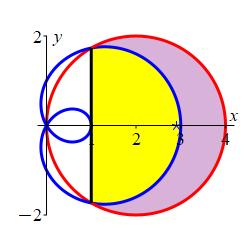
the center of mass for density \(\delta=\dfrac{1}{r}\)
Centroid
Recall that the centroid of a region \(R\) is the same as the center of mass but with constant density which we take as \(\delta=1\). Then the mass reduces to the area and the moments of mass become moments of area. Thus the centroid is: \[ \bar{x}=\dfrac{1}{A}\iint_R x\,dA \qquad \text{and} \qquad \bar{y}=\dfrac{1}{A}\iint_R y\,dA \] In polar coordinates, we express \(x\) and \(y\) in terms of \(r\) and \(\theta\), so that the formulas become \[\begin{aligned} \bar{x}&=\dfrac{1}{A}\iint_R r\cos\theta\,dA =\dfrac{1}{A}\iint_R r^2\cos\theta\,dr\,d\theta \\[10pt] \bar{y}&=\dfrac{1}{A}\iint_R r\sin\theta\,dA =\dfrac{1}{A}\iint_R r^2\sin\theta\,dr\,d\theta \end{aligned}\]
Find the centroid of the crescent shape.
Like the center of mass, the centroid of the crescent is not
within the crescent, but is within the convex hull of the crescent.
For the crescent, the convex hull is the pink and yellow region shown
in the plot.
The centroid is shown as a green circle.
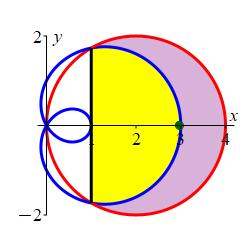
showing the centroid
Here is a blow-up of the edge of the crescent showing the
centroid with an \(\times\) and the center of mass with an \(\circ\).
Notice that the center of mass is to the left of the centroid:
\[
\bar{x}_\text{cm} < \bar{x}_\text{centroid}
\]
This is because the density \(\delta=\dfrac{1}{r}\) decreases to
the right, pulling the center of mass to the left.
The center of mass is shown as a blue star.
The centroid is shown as a green circle.
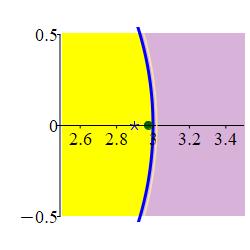
with the centroid and the center of mass
Average Value
Recall that the average value of a function over a 2D region, \(R\), is: \[ f_\text{ave}=\dfrac{1}{A}\iint_R f(x,y)\,dA =\dfrac{1}{A}\iint_R f(r,\theta)\,r\,dr\,d\theta \]
Compute the average density on the crescent shape if the density is \(\delta=\dfrac{1}{\sqrt{x^2+y^2}}=\dfrac{1}{r}\).
The exercises on the rest of this page refer to the quarter annulus which is the region between the circles \(r=3\) and \(r=5\) within the first quadrant. Find the limits of integration.
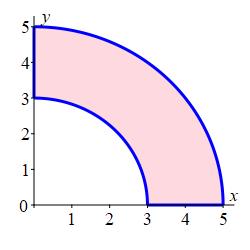
\(3 \le r \le 5\)
\(0 \le \theta \le \dfrac{\pi}{2}\)
This is a polar rectangle in the first quadrant: \[ 3 \le r \le 5 \qquad \text{and} \qquad 0 \le \theta \le \dfrac{\pi}{2} \]
mj
Find the volume of the solid above the quarter annulus below the surface \(z=\sqrt{x^2+y^2}\).
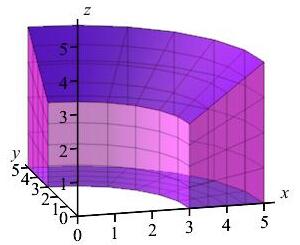
The volume below a function \(f\) is: \[ V=\iint_R f\,dA \] Express the function in polar coordinates and use \(dA=r\,dr\,d\theta\).
\(V=\dfrac{49\pi}{3}\)
In polar coordinates the surface is \(z=\sqrt{x^2+y^2}=r\). Using the limits found in the previous problem, the volume under this surface is: \[\begin{aligned} V &= \iint_R f\,dA = \int_0^{\pi/2} \int_3^5 r\cdot r\,dr\,d\theta \\ &= \dfrac{\pi}{2} \left[\dfrac{r^3}{3}\right]_3^5 = \dfrac{\pi}{6}(125-27) = \dfrac{49\pi}{3} \end{aligned}\]
mj
Find the area of the quarter annulus.
\(A=4\pi\)
We use the limits found in a previous problem: \[\begin{aligned} A &= \iint_R 1\,dA = \int_0^{\pi/2} \int_3^5 r\,dr\,d\theta \\ &= \dfrac{\pi}{2} \left[\dfrac{r^2}{2}\right]_3^5 = \dfrac{\pi}{4}(25-9) = 4\pi \end{aligned}\]
mj
Of course we can do this by high school geometry. The area of the annulus is \(A=\pi 5^2-\pi 3^2=16\pi\). So the area of a quarter annulus is \(A=\dfrac{1}{4}16\pi=4\pi\).
Find the mass of the quarter annulus if the mass density is \(\delta=x\).
If the density is \(\delta\), the mass is \(\displaystyle M=\iint_R \delta\, dA\).
\(M = \dfrac{98}{3}\)
In polar coordinates, \(x=r\cos\theta\), so \[\begin{aligned} M&=\iint_R \delta\, dA=\int_0^{\pi/2} \int_3^5 r\cos\theta \,r \,dr\, d\theta \\ &= \left[\rule{0pt}{10pt}\sin\theta\right]_0^{\pi/2} \left[\dfrac{r^3}{3}\right]_3^5 = \dfrac{1}{3}(1-0)(125-27) = \dfrac{98}{3} \end{aligned}\]
mj
Find the center of mass of the quarter annulus if the mass density is \(\delta=x\).
\((\bar x,\bar y)=\left(\dfrac{51\pi}{49},\dfrac{102}{49}\right) \approx(3.27,2.08)\)
We first compute the \(x\)-moment of mass: \[\begin{aligned} M_x &=\iint_R x\,\delta\,dA =\int_0^{\pi/2} \int_3^5 r^2\cos^2\theta \, r\, dr\, d\theta \\ &=\int_0^{\pi/2} \dfrac{1+\cos2\theta}{2} \,d\theta \int_3^5 r^3 \,dr =\left[\dfrac{\theta}{2}+\dfrac{\sin2\theta}{4}\right]_0^{\pi/2} \left[\dfrac{r^4}{4}\right]_3^5 \\ &=\dfrac{1}{4}(\dfrac{\pi}{4}+0-0)(625-81) = 34\pi \end{aligned}\]
We next compute the \(y\)-moment of mass: \[\begin{aligned} M_y &=\iint_R y\,\delta\,dA =\int_0^{\pi/2} \int_3^5 r^2\sin\theta\cos\theta \, r\, dr\, d\theta \\ &= \left[\dfrac{\sin^2\theta}{2}\right]_0^{\pi/2} \left[\dfrac{r^4}{4}\right]_3^5 =\dfrac{1}{8}(1-0)(625-81) = 68 \end{aligned}\]
Since we previously computed \(M=\dfrac{98}{3}\), we conclude: \[\begin{aligned} \bar x &= \dfrac{M_x}{M}=34\pi\cdot\dfrac{3}{98}=\dfrac{51\pi}{49}\approx 3.27 \\ \bar y &= \dfrac{M_y}{M}=68\cdot\dfrac{3}{98}=\dfrac{102}{49}\approx 2.08 \end{aligned}\] Thus the center of mass is at: \[ (\bar x,\bar y)=\left(\dfrac{51\pi}{49},\dfrac{102}{49}\right)\approx(3.27,2.08) \]
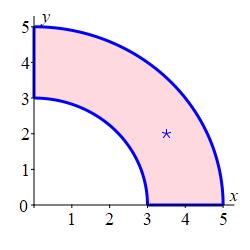
mj
Find the centroid of the quarter annulus.
\((\bar x,\bar y)=\left(\dfrac{49}{6\pi},\dfrac{49}{6\pi}\right) \approx(2.6,2.6)\)
We first compute the \(x\)-moment of area: \[\begin{aligned} A_x &=\iint_R x\,dA =\int_0^{\pi/2} \int_3^5 r\cos\theta \, r\, dr\, d\theta \\ &= \left[\rule{0pt}{10pt}\sin\theta\right]_0^{\pi/2} \left[\dfrac{r^3}{3}\right]_3^5 =\dfrac{1}{3}(1-0)(125-27) = \dfrac{98}{3} \end{aligned}\]
We next compute the \(y\)-moment of area: \[\begin{aligned} A_y &=\iint_R y\,dA =\int_0^{\pi/2} \int_3^5 r\sin\theta \, r\, dr\, d\theta \\ &= \left[\rule{0pt}{10pt}-\cos\theta\right]_0^{\pi/2} \left[\dfrac{r^3}{3}\right]_3^5 =\dfrac{1}{3}(0--1)(125-27) = \dfrac{98}{3} \end{aligned}\]
Since the area is \(A=4\pi\), we conclude: \[\begin{aligned} \bar x &= \dfrac{A_x}{A}=\dfrac{98}{3}\dfrac{1}{4\pi}=\dfrac{49}{6\pi}\approx 2.6 \\ \bar y &= \dfrac{A_y}{A}=\dfrac{98}{3}\dfrac{1}{4\pi}=\dfrac{49}{6\pi}\approx 2.6 \end{aligned}\] Thus the center of mass is at: \[ (\bar x,\bar y)=\left(\dfrac{49}{6\pi},\dfrac{49}{6\pi}\right)\approx(2.6,2.6) \] By symmetry we ahould have known that \(\bar x=\bar y\).
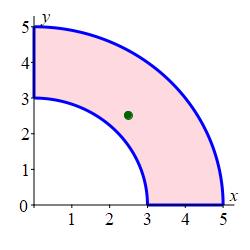
mj
This plot shows the center of mass as well as the centroid.
The center of mass is plotted as a blue star.
The centroid at is plotted as a green circle.
Notice that the center of mass is further to the right and below the
centroid because the density, \(\delta=x\), is bigger on the right
and the right side is below the center.
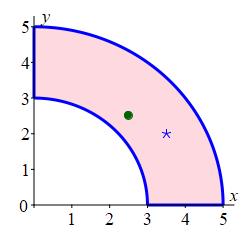
Find the average value of the function \(f(x,y)=\dfrac{1}{\sqrt{x^2+y^2}}\) on the quarter annulus.
\(f_{\text{ave}}=\dfrac{1}{4}\)
In polar coordinates, \(f(r,\theta)=\dfrac{1}{r}\), so \[\begin{aligned} \iint_R f\,dA &= \int_0^{\pi/2} \int_3^5 \dfrac{1}{r}\cdot r\, dr\, d\theta = \dfrac{\pi}{2} \int_3^5 1\, dr = \dfrac{\pi}{2}(5-3) = \pi \end{aligned}\] Thus \[ f_{\text{ave}}=\dfrac{1}{A}\iint_R f\,dA =\dfrac{1}{4\pi}\cdot \pi=\dfrac{1}{4} \]
mj
Heading
Placeholder text: Lorem ipsum Lorem ipsum Lorem ipsum Lorem ipsum Lorem ipsum Lorem ipsum Lorem ipsum Lorem ipsum Lorem ipsum Lorem ipsum Lorem ipsum Lorem ipsum Lorem ipsum Lorem ipsum Lorem ipsum Lorem ipsum Lorem ipsum Lorem ipsum Lorem ipsum Lorem ipsum Lorem ipsum Lorem ipsum Lorem ipsum Lorem ipsum Lorem ipsum